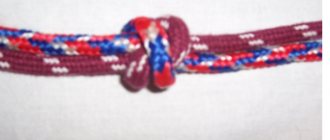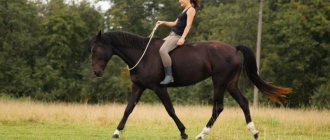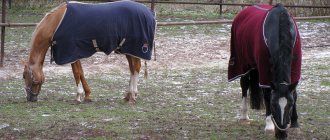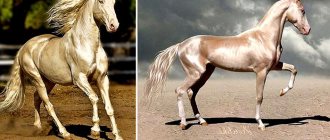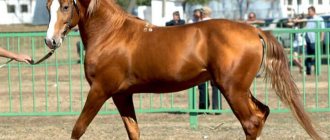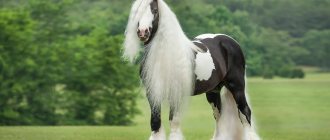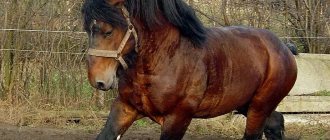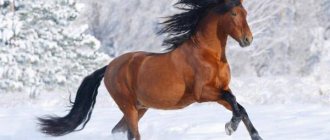Horses [edit | edit code ]
In horses, the withers are formed by the part of the spine between the 3rd and 11th dorsal vertebrae (most horses have 18 dorsal vertebrae), which are unusually elongated in this part of the body. In a horse, the vertebral processes can reach over 30 cm in length.
Since the withers do not move relative to ground level (in both horses and dogs), they are used to measure a horse's height. Typically, a horse's height is measured in palms - one palm measures 4 inches (10.16 cm). Horses can vary greatly in size, from small ponies to large draft horses. The average height at the withers of a purebred horse is 16 hands (1.6 m), for a pony - 14.2 hands (1.44 m).
Greek horses
So, let's find out how tall the Macedonian horses were. In the area of the small Greek city of Sindos near Thessaloniki, a tomb of a horseman was discovered, dating back to around the 4th century. BC [13]. The rider buried in it was a hetaira, a noble Macedonian cavalryman, and the horse, in turn, belonged to the Thessalian breed, its height was about 140 cm. Another find, dating back to the 6th-7th centuries BC. in the cemetery of Polykastron [14] also shows a noble Macedonian and his horse, 1.45 m tall at the withers.
Fresco from a tomb on the island of Agios Athanasios
Horse height at withers
A horse's height is measured from the withers to the ground. The withers are the place on the back between the third and eleventh vertebrae. In most animals it is the highest part of the body, but only in horses and dogs the withers are motionless, and therefore serve as a reference point for measuring height.
The height of horses varies from 70 cm to 2 m. According to these data, they are conventionally divided into four groups.
Small-growing
Low or undersized horses include breeds whose height is no more than one and a half meters. Their most prominent representatives:
- pony;
Kuznetsk horse breed
Kuznetsk horse breed
This breed was bred in the second half of the 19th century. in Western Siberia by migrant peasants. Kuznetsk horses are perfectly adapted to the harsh conditions of Siberia.
The average measurements of adult individuals are according to the above characteristics: 152.2 cm, 158.8 cm, 156.6 cm, 20.6 cm. Animals of this breed are distinguished by a strong constitution, a large head, a medium-length neck, with wide and high withers, long back and lower back, wide and muscular croup, deep and broad chest. These horses are very efficient. They remain active until the age of 25.
(Visited 234 times, 1 visits today)
Vitamins for horse growth
Sometimes owners feel that their pets are not growing well. Horses may indeed not gain height that is appropriate for their age and breed. In such cases, it is recommended to add special additives to the feed that stimulate this indicator. Some breeders produce horse calcium or calcium with phosphorus, nutril selenium, Omega-3 complex. The dosage of each is usually indicated on the package.
Generally speaking, vitamin supplements come in injection or granule form and should include:
- vitamins - A, D, H, K, C, group B;
- micro- and macroelements - calcium, magnesium, zinc, selenium, phosphorus and others.
It should also be remembered that a good balanced diet, in particular fresh grass, is also a source of vitamins for the four-legged animal. If there is enough of everything, then vitamins may be needed to maintain the health of the horse and your own peace of mind.
Record-breaking horses
Horses with the largest and smallest stature evoke tenderness and admiration. Here are some examples of such achievements:
- The honorary title of the tallest horse on the planet belongs to a Brabancon named Big Jake from America. His height is two meters seventeen centimeters, which was officially recorded in the Guinness Book of Records in 2010. This Belgian gelding weighs just over two and a half tons and has a very friendly character.
- Before Big Jake, the height laurels belonged to a Shire draft horse named Remington from Texas, America. He is 7 centimeters smaller than today's king.
- The absolute record for horse height has not yet been broken and it belonged to a shire named Sampson. He lived at the end of the nineteenth century in the English province of Bedforshire and measured two hundred and twenty centimeters from the ground to the withers. Its weight was more than one and a half tons.
- A shire named Duke now living in Great Britain may soon overtake the current record holder. Now his height is two meters and seven centimeters and he gains about 8 cm every year. The owners do not reveal the secret of his nutrition; We only know that the horse’s diet includes about 10 kg of grain, special varieties of apples, herbal infusions, tea and a hundredweight of water every day.
- The smallest horse in the world is named after the great physicist. A Pinto stallion named Einstein lives in New Hampshire, America, weighs just under three kilograms and is only thirty-five centimeters in height.
Horses have occupied a special place in human life since ancient times. They are incredibly beautiful, graceful and smart. Breeds differ from each other; there are big and small horses. But the love of a four-legged friend for his owner remains unchanged.
How much does a horse and horse weigh on average?
The dimensions of a horse - height, weight and body length - depend not only on age, but also on breed. For example, a miniature pony is much lighter than a massive draft horse, and a long-legged Arabian horse is heavier than a short falabella. You can find out how much a particular horse weighs by weighing the animal and taking special body measurements.
Classification by weight and degree of fatness
The weight of a horse is one of the important parameters for classification. There are three main groups:
- Easy. This category includes horses weighing up to 400 kg. There is no minimum value, so the group includes both ponies and racehorses.
- Average. The weight of animals in this category is from 400 to 600 kg.
- Heavy. Giants from this group weigh over 600 kg.
Some sources identify a separate subgroup for horses weighing less than 200 kg.
The weight of an adult animal can change throughout life. This is influenced by the care, nutrition and condition of a particular individual.
Sometimes horses are purposefully put on a diet or fattened, because speed and other productive characteristics depend on weight. Experts distinguish several categories of fatness:
- Unsatisfactory. When you look at such a horse, you feel pity. Protruding ribs, bones of the croup and shoulder blades, lack of subcutaneous fat and lack of muscle indicate poor nutrition and hard work. This condition is caused by poor treatment by the owner, old age or serious illness.
- Sports. Jumping and racing require strong muscles and a toned physique. Training horses have virtually no subcutaneous fat, but they look healthy thanks to their developed muscles. After finishing their sports career, racers often gain fat and move to another category.
- Working. Horses cannot boast of being particularly slender - they are fattened, but the fat does not have time to accumulate due to hard work. This category includes animals engaged in agricultural work, giving rides to tourists and carrying cargo.
- Factory. The horses are intended for breeding, they are well fed, but not allowed to become fat. Stallions are active and mobile, and mares easily bear and give birth to offspring.
- Exhibition. Animals are fattened to participate in shows and exhibitions. Shiny coat and rounded shapes make horses extremely impressive and attractive.
How are breed and weight related?
Within the same breed line, the mass of animals does not differ much. Of course, there are exceptions in the form of giants or miniature individuals. Knowing what breed a particular animal belongs to, you can approximately determine its weight. A table with average weights of popular pedigrees can be used when assessing a horse's body condition.
| Category | Breed | Weight, kg |
| Lightweight (up to 400 kg) | American miniature | 50–70 |
| Falabella | 20–60 | |
| Shetland pony | Up to 200 | |
| Australian pony | Up to 270 | |
| Welsh pony | 300–350 | |
| Medium (400–600 kg) | American, Russian and other trotters | 400–500 |
| Arabian horse | 450 | |
| English thoroughbred | 450–550 | |
| Trakehnens and Budennovites | 500 | |
| Holstein | 550 | |
| Heavy (600–900 kg) | Arden heavy truck | 700–900 |
| Vladimir heavy truck | 900 | |
| Tinker | 700 | |
| Suffolk | 700–900 | |
| Frieze | 600–700 | |
| Very heavy (800–1200 kg) | Shire | Over 900 |
| Percheron | Up to 1000 | |
| Brabançon | 800–1100 | |
| Clydesdale | 800–900 |
How much does a horse weigh on average?
An adult draft or riding breed weighs from 450 to 700 kg.
At the lower limit of this value are indigenous breeds (Kyrgyz, Mongolian), which were formed in harsh climatic conditions and on a meager diet.
However, low weight does not prevent animals from showing record endurance during long treks to the steppes. Aboriginal individuals can carry a load of up to 150 kg on their back, which is a third of their own weight.
Breeds bred by humans for racing (English Saddlebred) are tall at the withers and weigh up to 600-650 kg. The impressive parameters of the animal, the structural features of the body, and long legs allow the horse to develop high speed and make long and high jumps.
Separately, it is worth noting the heavy-weight groups, with a body weight exceeding 800 kg. Once borne by heavily armored knights, these animals possess enormous strength. Due to their large dimensions, heavy trucks are not capable of developing high speeds, but at a pace these giants transport luggage weighing several tons.
How to measure weight
To carry out medical procedures (calculating the dosage of a medicine), counting food in the diet, you need to know the weight of the pet at the current moment.
If there are no scales on the farm, you can determine the weight of a horse by measuring its body. There are ways to determine mass using tables and calculations that allow you to find it out most accurately.
The measurements are valid for an animal with average (normal) fatness.
- The chest circumference of a horse standing calmly on a flat surface is measured with a special measuring tape. The tape is placed immediately behind the animal’s shoulder blades, thrown over the withers so that it fits snugly to the body. The value indicated on the tape will be the weight of the individual. Different breed groups of horses have their own measuring tapes.
- According to Durst's formula, the height of a stallion or mare at the withers, calculated in centimeters, is multiplied by a coefficient - a number that is constant in its value. For light breeds it is 2.7, for draft horses - 3, for heavy draft horses - 3.6. The number obtained as a result of multiplication will reflect the mass of the animal. Example: the height of a stallion of the Orlov breed is 162 cm, multiply by 3, since the Orlov breed is a draft breed, the weight will be 486 kg.
- According to Motorin's formula, the circumference of the chest (measured as indicated in the first paragraph) in centimeters is multiplied by a constant number 6, and 620 is subtracted from the resulting product. It is a mistake to measure the circumference of the horse's belly; the tape is placed on the chest.
Formulas and measurements have an error that can reach 20-30 kg. If you need to know the weight with an accuracy of 5 kg, use scales.
How much does an adult horse weigh?
An adult is considered to be an individual that has reached the age of 4-7 years (the earliest ripening are heavy draft breeds, the late ripening are trotters). By this time, the animal’s weight in kilograms reaches 100% of the potential inherent in nature; whereas at birth it does not exceed 8-10%.
The average weight of a horse from the category of light breeds is 500 kg, heavy breeds - twice as much.
Dwarf or mini-horses (falabella, appaloosa) are popular in the world. Their weight in adulthood rarely exceeds 50 kg, and their height is about 40-60 cm. At the same time, small horses can carry a load of up to 100 kg in a harness.
Heavy trucks
The horses, impressive in their dimensions, are real heroes, capable of transporting loads weighing several tons. The record holder in the transportation of heavy loads was the stallion of the Soviet draft breed Force, which moved a load of 23 tons.
The weight of a heavy breed horse ranges from 800 to 1400 kg. The record value was recorded for a Shire stallion, it was more than 1500 kg.
What is the weight of foals at birth?
The weight of a newborn foal depends on the breed of its parents and can vary by 20-30%. The average normal weight is considered to be 40 kg. If the baby's birth weight is much lower, he may not have enough strength to stand on his feet and find his mother's udder in time. In such situations, human help is necessary - artificial feeding will be required.
What is the height of a horse at the withers
A horse's height is usually measured from the ground to the highest point of the withers. The height of a horse depends on its breed. All animals are divided into groups according to height and body length:
- dwarf and ponies - up to 120 cm at the withers;
- short - from 100 to 145 cm;
- average height - 150-165 cm;
- tall - over 170 cm.
The tallest horse breeds are the Brabançon, Clydasle and Shire. Their height at the withers exceeds 210 cm.
The existing dimensions of animals of different breeds determine their economic use for many years.



